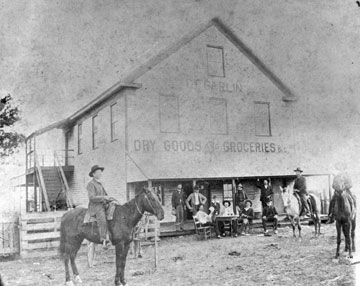Willow Springs, a Community Known by Many Names
by Rox Ann Johnson
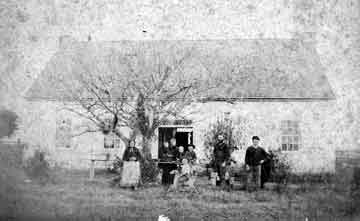 The Willow Springs community lies west of Cummins Creek in the James Miles and John Andrews Leagues in the southeastern corner of Fayette County. David and Sarah Davis Breeding who came from Kentucky were early settlers in the area. The first known school session in the county occurred on the Breeding’s land in 1834, taught by a Mr. Rutland. McGinnis was another early family in the area.
The Willow Springs community lies west of Cummins Creek in the James Miles and John Andrews Leagues in the southeastern corner of Fayette County. David and Sarah Davis Breeding who came from Kentucky were early settlers in the area. The first known school session in the county occurred on the Breeding’s land in 1834, taught by a Mr. Rutland. McGinnis was another early family in the area.
With the first permanent German settlement in Texas only a few miles to the east at Industry, it’s no surprise that immigrants also established farms in the Willow Springs area. The Albrechts, Hennigers, Krebs, Muellers, Muenzlers, Pagels, Sauers, Schulzes, Scharnbergs, and Weidemanns were some of the earliest immigrants to locate there. In the late 1850s and 1860s, the term “Briten” Settlement—and other similar spellings that appear to be variations on the Breeding name—was used by the German-speaking Lutheran Pastor at nearby Frelsburg, Rev. J. C. Roehm, to describe the birthplace of local children.
In 1870 Rev. Roehm used the term “Pagel settlement” to describe the community. The Pagels had immigrated in 1850 and farmed just west of Cummins Creek. In 1866, after his father and most of his siblings had moved on to Lavaca County, the oldest son, F. Wilhelm Pagel, bought additional property at what is now the intersection of State Hwy 159 and FM 954. He dug a root cellar and built a house over it with thick rock walls covered with stucco. Pagel ran a general merchandise store on his property and the local community became known as Rock House, named after Pagel’s home, when he became its first postmaster on October 12, 1871. The name Rock House was still in use long after Wilhelm Pagel died in 1873 and his wife relinquished the post office, which was officially moved a few miles east into Austin county where the new postmaster, Ernst Witte, lived.
In 1880 Charles T. Zapp purchased one and a half acres to build a house and store across the road from the Pagels at the location of today’s Minssen Store. The following year he established a post office in the store, and the community was known for a time as Zapp or Zapp Post Office. Charles F. Garlin bought the store and served as the Zapp postmaster from 1892 until 1902, before selling it back to C. T. Zapp, who ran the post office again until it was discontinued in 1906.
Since the 1870s the community’s school located near the Willow Springs branch was called the Willow Springs School. Throughout all the post office changes the community was alternatively known as Willow Springs, the name it bears today.
Photograph: The Rock House at Willow Springs, ca 1893. From left: Johanna Pagel; Oscar, Emma, Lillie, Ed, Willie and Ernst Albrecht; and possibly Franz Brauner
Catastrophic Hail at Willow Springs
by Rox Ann Johnson
The Willow Springs community, then known as Zapp, suffered a catastrophic hailstorm at about four o'clock in the afternoon of May 31, 1907. Here is a first person account of it, written by Charlie T. Zapp and published in the June 15, 1907 Weimar Mercury:
Hail in Fayette County.
The following letter was received here yesterday by Mr. Robert Zapp from his cousin:
Zapp, Fayette Co., Tex., June 2.
We are nearly over our big fright of Friday evening. I have heard of hailstorms, but nothing like this one – hail from the size of hen eggs up to the size of your fist. It broke 123 window panes and window sash for us; cracked and broke the blinds and split all the shingles on the north and west side of the houses, unroofing some; knocked some off their foundation, and holes in some roofs as big as a hat, and water just poured into the broken windows in torrents. Biggest rain we ever heard of, afterward doing much damage (you know our store is two-story).
Storm twisted off our new windmill, destroyed fences, uprooted trees; not one leaf left on many large trees, nor on corn and cotton, vegetation, etc. Even weeds were all killed by hail in fields and pastures, and not thirty days’ feed left of neither hay nor corn of 1906 crop, and price raised at once at Fayetteville to $1 per bushel for corn. Two of our horses and many others ran into the barbed wire fences through fright and were butchered up considerably. I expect one of our nice blacks will die. Hundred of chickens, rabbits, snakes and thousands of birds were killed by the hail, which was found (the hail) after the storm was over in piles from two feet up to five feet high against the houses and in the low places, and there is plenty of the hail to be found yet this evening at 7 o’clock, in spite of the hot sun and clear skies for two days past – something unheard of and which probably can not be believed by a living soul not here to see for himself.
The bark was literally peeled off from many large trees, especially fruit trees. All orchards are ruined – not fruit, nor even a leaf, left on them. Hail and rainstorm lasted thirty to forty minutes. Everything will have to be planted over when dry enough. After six or eight week’s continual rains here (think of it!), say middle of June, what will we get? I expect to lose nearly all I sold on a credit, as this is the Mexican weevil district, and it is also much too late. As far as I know, the hail started near Warrenton and extended east to Sealy (about forty miles), in Austin county. Fayetteville was not touched.
C. T. Zapp
In an interview more than eighty years later, Ellis Garlin vividly remembered Willow Springs' frightening storm that occurred when he was seven years old. Ellis had crawled inside a barrel brought into the house from the front porch to avoid the baseball-size hail crashing through the windows. He remembered with irony that, amid all the destruction, hail had knocked a cup off the kitchen table without breaking it. The local mail carrier, Albert Schulze, had been caught in the storm and drove his horse and mail wagon right under the Ernst Albrecht family's covered porch to save himself. The big hailstorm of 1907 was definitely an unforgettable act of nature.
1930s Girls Team from Willow Springs School
by Gesine (Tschiedel) Koether
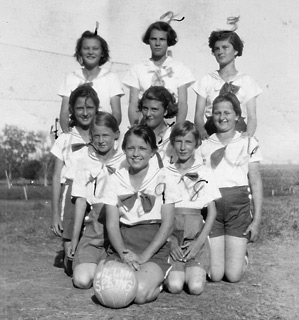 Awhile back I wrote an article about my mother, Isabella (Henniger) Tschiedel, and her attending the Willow Spring School here in Fayette County in the early 1930s. The Willow Springs Public School sign on Hwy 159 is about seven miles outside of Fayetteville and my mom’s home was at Cummins Creek. In her school keepsake book were the two photos seen above. One is clearly the Willow Springs School. The other shows nine female students in uniforms from sometime around 1930. My curiosity was piqued to learn more about this team and hope someone could confirm that this was the Willow Springs Girls Volleyball team of the early 1930s.
Awhile back I wrote an article about my mother, Isabella (Henniger) Tschiedel, and her attending the Willow Spring School here in Fayette County in the early 1930s. The Willow Springs Public School sign on Hwy 159 is about seven miles outside of Fayetteville and my mom’s home was at Cummins Creek. In her school keepsake book were the two photos seen above. One is clearly the Willow Springs School. The other shows nine female students in uniforms from sometime around 1930. My curiosity was piqued to learn more about this team and hope someone could confirm that this was the Willow Springs Girls Volleyball team of the early 1930s.
My research, on Ancestry, verified all the girls listed were born around the same time as my mom, which was, ‘between’ 1921 to 1923. Many of these families were listed on the same 1930 census page. My mom had carefully written the names of each girl on the back of the team photo.
The back row, with numbers 1-3, are Violet Coufal, Julie Kulhanek and Evelyn Orsak. The middle row, with numbers 4-6, are Cora Nell Strickland, Estelle Ann Muenzel and Roxie Krebs. The next row, with numbers 7 and 8 are Annastina Aschenbeck and Gladys Rodgers. In front, number 9, is Ora Albert.
Only two photos and a list of nine names. Many of these same girls’ signatures are found in my mom’s school autograph book. These same family names would be found on my grandparents, Reimund and Emma(Scmidt) Henniger funeral books. Memories and friendships run deep in our small communities of Fayette County, Texas
There are over two hundred schools listed in historical files in the Fayette County Heritage Archives. This list includes schools from 1834 forward, including rural community schools for both white and African American students as well as parochial schools. Today in 2020, there are five Independent School Districts in Fayette County located in La Grange, Schulenburg, Flatonia, Round Top-Carmine and Fayetteville.
Texas public schools have come a long way since those early days of Texas statehood. Progress is great, but those small rural community schools served a vital role in educating our ancestors. It seems team sports are still alive and well in our Fayette County Schools.
I should mention that one evening when I was in my early teens a group of neighborhood kids were playing volleyball in the backyard. We only had four players and were not talented enough to keep the ball in play. Both my parents and the neighbor’s parents told us to take one side of the net and they would take the other. None of us had ever seen our parent play volleyball but that summer evening they beat the pants off of us kids. What a surprise to learn your parents could beat you at volleyball.
My mom is gone and I will never know whether she had tried out for the Willow Springs volleyball team or not. I will continue my search at the Fayette Heritage Museum and Archives and hopefully will gather enough information to write more stories about the schools in Fayette County.
Picture courtesy of Gesine Koether
Sources:
Ancestry.com
“Fayette County School Project”, Fayette County Record, p.1; July 16, 1996
Rox Ann Johnson, Fayette Heritage Museum and Archives
Zapp [Willow Springs] is situated about seven miles north of Fayetteville in the extreme eastern portion of the county on Willow Spring. A more pleasing landscape can hardly be found in the state. The elegant white painted farmhouses, the substantial large barns, in the midst of verdant fields, speak of the industry of its people. The people are well-to-do, independent and contented. They enjoy life, being well fixed against any contingencies. The population is German and Bohemian. The place was named after C. T. Zapp, who was the first postmaster in that place (1881.) [This is incorrect. See note 1 below.] Zapp is also called Willow Springs, after the school by that name, which for the last few years has been under the able direction of a thorough and conscientious teacher, Prof. Wm. Haverlah.
C. F. Garlin, a very accommodating gentleman, is the present postmaster and merchant of that place. His reliability and congenial ways deserve the custom of the neighborhood. Ad. Weige is a young blacksmith at that place, a skillful workman and a good honest man. L. C. Muenzler owns a very fine gin, does very good work in his line and satisfies his customers. [Each of the preceding bought advertisements in Lotto's book.]
Zapp is a very old settlement. It was settled early in the thirties and as early as 1839 it is spoken of in the minutes of the commissioners' court as the German settlement. Old settlers are F. Garlin, Ad. Schulz, Wm. Krebs, Gerh. Heinsohn, Wm. Weidemann, F. Scharnberg, Mrs. Johanna Heinsohn (age 96 years)[see note 2], Julius Krebs. Among the old settlers who have passed from life and gone to whence there is no return Carl Albrecht, A. Muenzler, F. Pagel, Christian Henniger may be named.
From the Day Book of Hermann John Meitzen, who taught at the Willow Springs School, we know that school was conducted there in November 1875. There was an entry for November 4th where "F. Scharburg, F. Garlin, and W. Weidermann arrived to complete the school's water well." We know that church services were held in the school house on Sunday, November 7, beginning at 3 o'clock, and again on Sunday January 2, 1876, when Clara Braüer and Friedrich Kruse were married after the service.
On Sunday, January 9th of that year, a meeting was held at the school with only a few members present, but the group decided to fence the school property. On January 13, "F. Scharnberg, F. Garlin, A. Münzler, H. Glass, F. Bülow, F. Riske and others arrived to fence in the property. The task progressed well because four men dug holes and the others set the posts and nailed the boards." Meitzen conducted class as usual. The fence was completed two days later, though Meitzen did further work on it later in the month. On January 17, Meitzen went to Mr. Ladewig's and picked up small trees which he planted in the school yard. He remarked that on January 25, 1876, a large number of Bohemian children enrolled at school. On Tuesday, February 15, 1876, there was no school because of the election in the school house where local men voted on all offices from governor down to constable. The diary ended on February 23 of that year.
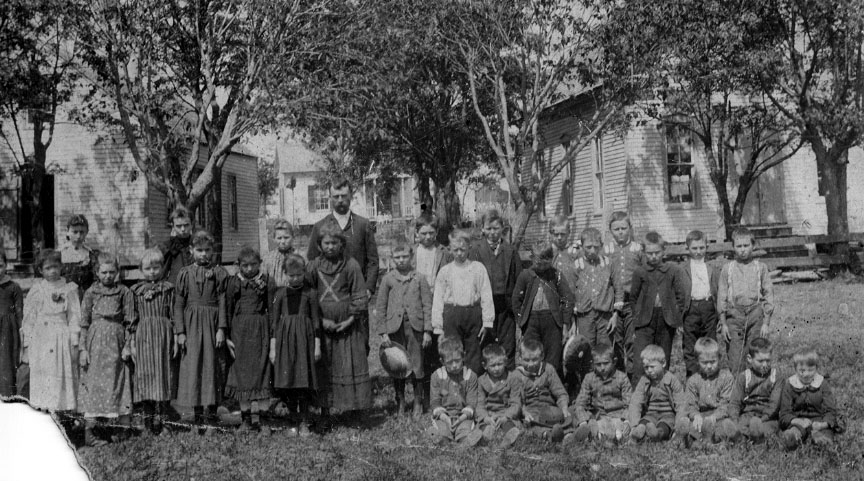 |
Willow Springs School, 1890s
Teacher is Ernst Theodore Heinsohn.
Click on photo for enlarged view.
If you can identify anyone in this photograph or the school photos below, please e-mail Rox Ann Johnson.
|
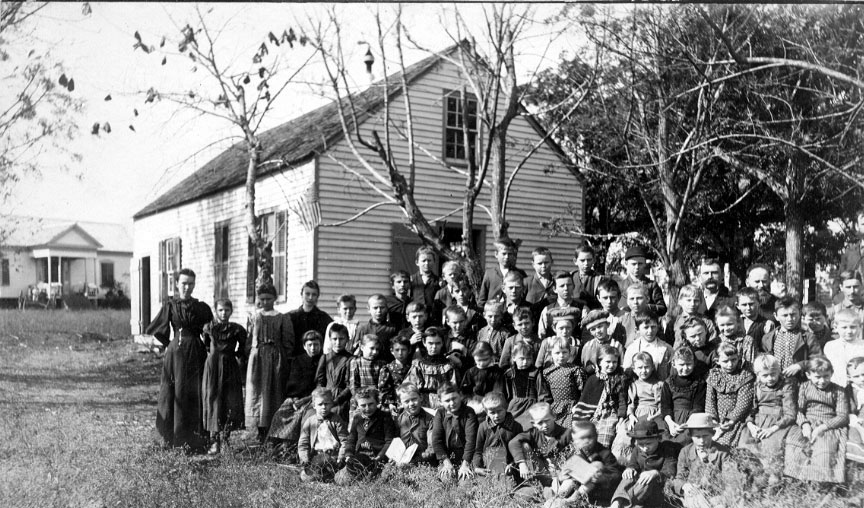 |
Willow Springs School, ca 1895
Ernst Theodore Heinsohn, with moustache, teacher at Willow Springs from 1889-1898. Right of him is Ernst Albrecht, school trustee. Man in back on far right is L. C. Muenzler. Werner & Theodore Zapp are farthest left on the front row.
Click on photo for enlarged view.
|
 |
Willow Springs School, ca 1899
The male teacher was Henry Dreyer, teacher from 1898-1900. The female teacher is probably Nora or Arminda Simmons.
If you can identify anyone in this photograph or any of the school photos, please e-mail Rox Ann Johnson. Click on photo for enlarged view.
|
 |
Willow Springs School, 1902
A few students have been tentatively identified by Rox Ann Johnson and Laura Campagna:
Back Row: 4th from Left (tallest boy) is Theodore (Pelly) Zapp
Third Row: Teacher 4th from left is Ida Heinsohn; teacher 7th from left is F. M. Banks; 2nd from right, Ida Kruse; far right, Ella Pagel
Second Row: 4th from left, Lola Pagel; 2nd from right, Sophie Minnie Kruse; far right, Lillie Albrecht
Bottom Row: 5th from left is Fred Banks (barefoot and holding sign). Ned Banks is 7th from left and holding dog.Tom Banks is second from righ; Far right is Oscar Albrecht;
Other Willow Springs students who are probably on the photo include Norma Henniger, Erna Henniger, Laura Henniger, Reimund Henniger, Bennie Kruse, Mary Kruse, Frank Pagel, Leo Pagel, Willie Pagel, Werner Zapp, and Bernetta Zapp.
Photo contributed by Laura Campagna. Click on photo for enlarged view.
|
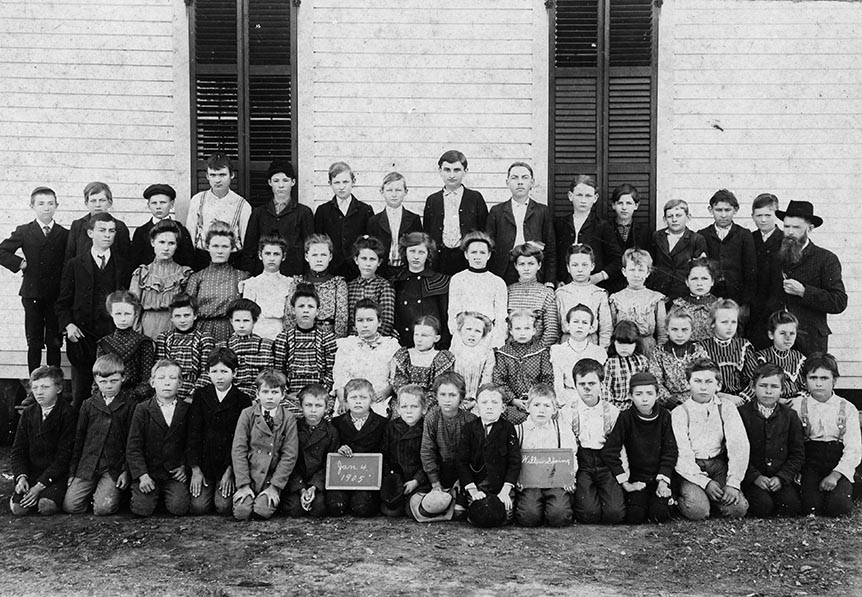 |
Willow Springs School, 1905
Back row: Ned Banks is leftmost
Third row: Tom Banks, assistant teacher is holding his hat at left; F. M. Banks is the teacher on the right.
Second row: Kate Banks is probably the little girl fourth from right
Front row: Fred Banks is fourth from right.
If you can identify anyone in this photograph or any of the school photos, please e-mail Rox Ann Johnson. Click on photo for enlarged view.
|
 |
Willow Springs School, ca 1909
Teacher at center is Charlie Behrens. Olga Heinsohn is third from right on the top row. Do you recognize others?
Click on photo for enlarged view.
|
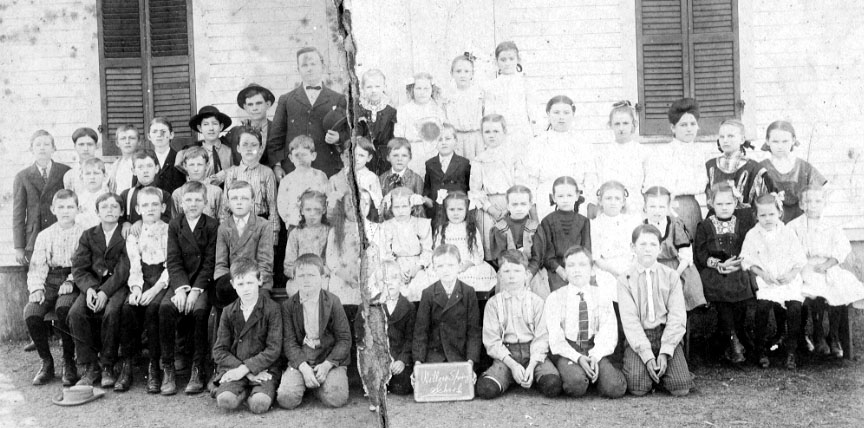 |
Willow Springs School, ca 1910
Back row: Professor Charlie Behrens, back row
Third row: 2nd from right is Olga Heinsohn
Click on photo for enlarged view.
|
|
|
|
 |
Willow Springs School, 1932-1933.
Third row: W. E. Rodgers; prinicpal.
Second row: Gladys Schultz is seated third from right on the second row. Anita Marek is rightmost.
Bottom row: Burney Hartmann is fourth from left. |
 |
Willow Springs School, ca 1935
Back Row: Roxy Krebs, Gladys Rodgers, Cornelia __, Estelle Muenzler, Marie Marek, ___, Isabella Henniger, __ Coufal, Julie Kulhanek, ___, Doris Malek, Ora Albert, ___, Anastina Aschenbeck
Third Row: Teacher at left is W. E. Rodgers; next are Ted Heinsohn, Gilbert Rodgers, ___, Albert Aschenbeck, Steve Kasmiersky, Wilkens Krebs, Leopold Kulhanek, Alvin Minarcik, Alvin (or Leroy) Krenek; teachers at right are B. J. Coufal and Bernita Muenzler.
Second Row: Winnie Mae Henniger, Dorothy Minarcik, Alita Henniger), Adeline Coufal, Annie Mae Kasmiersky, ___, ___, Bernice Eckermann, ___, Mariam Henniger, Evelyn Ann Minarcik, Gladys Schultz, Doris Hartmann, Pearly Kruse, ___, Anita Marek
Bottom Row: Burney Dalton Hartmann, Delton Linke, Jerry Coufal, Emmett Coufal, Frank Marek (behind the sign), Warren Albrecht, ___, Alton "Mutsy" Zenkner, ___, ___, ___
Click on photo for enlarged view.
All school photographs on this page except 1902 Willow Springs School contributed by Rox Ann Albrecht Johnson.
|
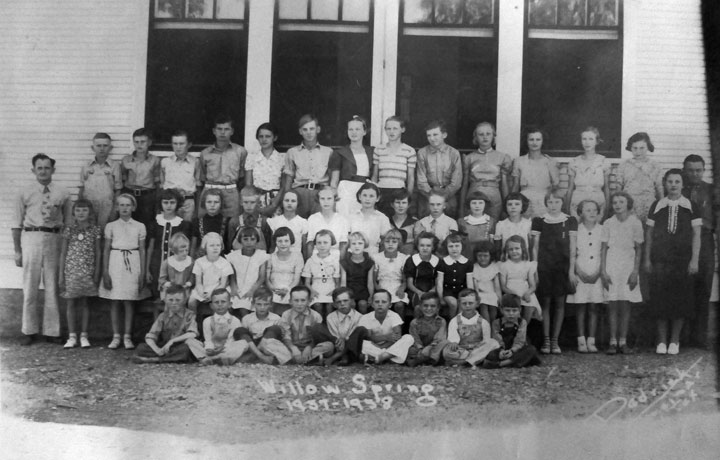 |
Willow Springs School, 1937-38.
Gus Steinmann; teacher on left. Bernita Muenzler and B. J. Coufal; teachers on right.
Back row: Burney Hartmann is 2nd from left
Third row: Doris Hartmann is third from left; Blonde girl, 7th from left, standing in center of third row is Anita Marek; next to her with the bow in her hair is Gladys Schultz. Boy with tie; two people over is Warren Albrecht.
If you have a clearer version of this photograph, please contact Rox Ann Albrecht Johnson. |
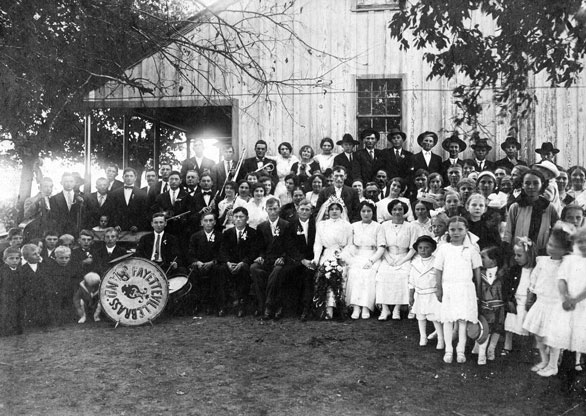
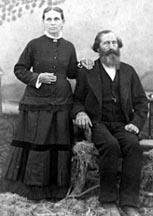
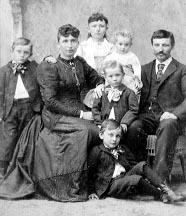

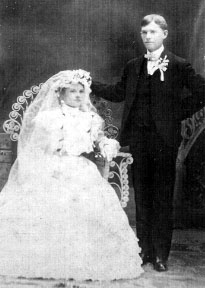
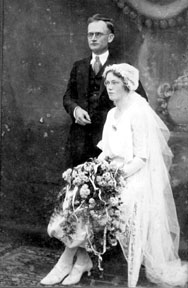
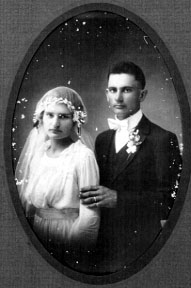

 The Willow Springs community lies west of Cummins Creek in the James Miles and John Andrews Leagues in the southeastern corner of Fayette County. David and Sarah Davis Breeding who came from Kentucky were early settlers in the area. The first known school session in the county occurred on the Breeding’s land in 1834, taught by a Mr. Rutland. McGinnis was another early family in the area.
The Willow Springs community lies west of Cummins Creek in the James Miles and John Andrews Leagues in the southeastern corner of Fayette County. David and Sarah Davis Breeding who came from Kentucky were early settlers in the area. The first known school session in the county occurred on the Breeding’s land in 1834, taught by a Mr. Rutland. McGinnis was another early family in the area. Awhile back I wrote an article about my mother, Isabella (Henniger) Tschiedel, and her attending the Willow Spring School here in Fayette County in the early 1930s. The Willow Springs Public School sign on Hwy 159 is about seven miles outside of Fayetteville and my mom’s home was at Cummins Creek. In her school keepsake book were the two photos seen above. One is clearly the Willow Springs School. The other shows nine female students in uniforms from sometime around 1930. My curiosity was piqued to learn more about this team and hope someone could confirm that this was the Willow Springs Girls Volleyball team of the early 1930s.
Awhile back I wrote an article about my mother, Isabella (Henniger) Tschiedel, and her attending the Willow Spring School here in Fayette County in the early 1930s. The Willow Springs Public School sign on Hwy 159 is about seven miles outside of Fayetteville and my mom’s home was at Cummins Creek. In her school keepsake book were the two photos seen above. One is clearly the Willow Springs School. The other shows nine female students in uniforms from sometime around 1930. My curiosity was piqued to learn more about this team and hope someone could confirm that this was the Willow Springs Girls Volleyball team of the early 1930s. 